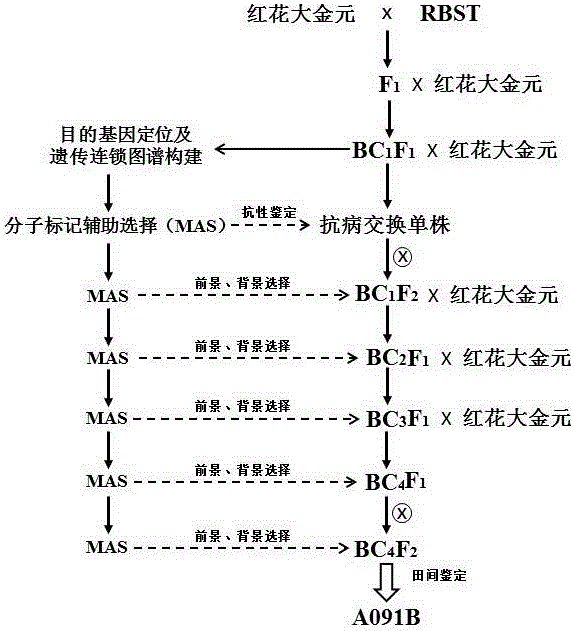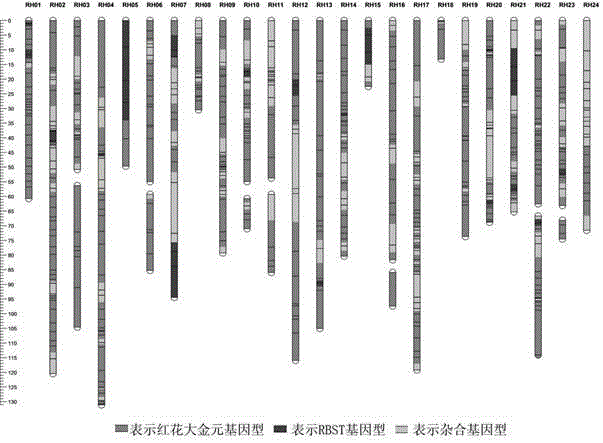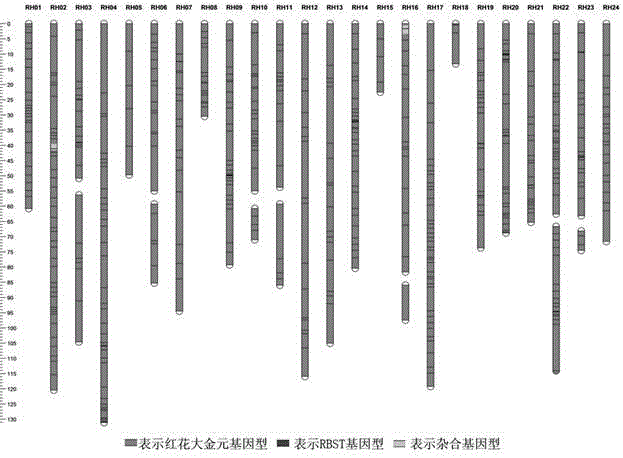Breeding method for directed improvement of tobacco black shank resistance by molecular marker-assisted selection
A molecular marker-assisted, tobacco black shank technology, applied in biochemical equipment and methods, microbial determination/inspection, etc., can solve the loss of black shank resistance, the inability to maintain safflower, and field characteristics. The problem of heavy workload, etc., can achieve the effect of increasing the resistance to black shank disease, improving the background recovery rate, and growing neatly in the field.
- Summary
- Abstract
- Description
- Claims
- Application Information
AI Technical Summary
Problems solved by technology
Method used
Image
Examples
Embodiment 1
[0054] Example 1: Acquisition of foreground and background molecular markers
[0055] The 23626 SSR markers developed with the whole genome data of Honghua Dajinyuan were used to test the recurrent parent Honghua Dajinyuan, the donor parent RBST (Chinese invention patent ZL201410819251.2) and its f 1 The DNA extracted from the leaves was screened for molecular markers in the laboratory of No. 14 Nanxiang Road, Yuxi City, Yunnan Academy of Tobacco Agricultural Sciences. 1 601 co-dominant molecular markers were used in the map software Joinmap 4.0 to compare 601 markers in 213 BC strains obtained in Datian, Yunnan Academy of Tobacco Agricultural Sciences Research and Experimental Base 1 f 1 The mapping population was subjected to genotype analysis of molecular markers and the construction of a genetic linkage map. Finally, a high-density genetic map covering the entire tobacco genome containing 581 SSR markers was constructed. Combined with 3 batches of 8030 BC plants in the g...
Embodiment 2
[0056] Example 2: BC 1 f 2 marker assisted selection
[0057] BC in 2012 1 f 1 BC obtained by selfing of resistant single plant 1 f 2 , BC 1 f 2 Seedlings were sown in 3 trays (128 plants / tray), transplanted to small flower pots after seedlings were grown, and then identified for resistance to blackleg disease after returning seedlings. A single plant without disease was transplanted to the field, and a total of 90 plants were transplanted. Leaf DNA of a single plant without disease; first use the four foreground markers Scf_30K, TM62, ST141 and InDel0617 that are closely linked to both sides of the blackleg resistance gene to help prospect selection, select a single plant containing the blackleg resistance gene, and then use the 24 linkage groups on the genome-wide genetic map of the improved original variety, and 5 background markers were selected for each linkage group, a total of 120 background markers evenly distributed in each linkage group assisted background sel...
Embodiment 3
[0058] Example 3: BC 2 f 1 marker assisted selection
[0059] BC 2 f 1Seedlings were sown in 5 trays (168 plants / tray), transplanted to small flowerpots after seedlings were grown, and identified for resistance to black shank after returning seedlings. A single plant without disease was transplanted to the field, and a total of 306 plants were transplanted. Leaf DNA of a non-infested individual plant; first use 4 foreground markers Scf_30K, TM62, ST141 and InDel0617 closely linked to both sides of the black shank resistance gene to assist foreground selection, and select a single plant containing the black shank resistance gene; based on construction 24 linkage groups on the whole genome genetic map of the original variety, and 5 background markers were selected for each linkage group, a total of 120 background markers evenly distributed in each linkage group were used to assist in the preliminary selection of the background. 33 individual plants with high recovery rate; t...
PUM
 Login to View More
Login to View More Abstract
Description
Claims
Application Information
 Login to View More
Login to View More - R&D
- Intellectual Property
- Life Sciences
- Materials
- Tech Scout
- Unparalleled Data Quality
- Higher Quality Content
- 60% Fewer Hallucinations
Browse by: Latest US Patents, China's latest patents, Technical Efficacy Thesaurus, Application Domain, Technology Topic, Popular Technical Reports.
© 2025 PatSnap. All rights reserved.Legal|Privacy policy|Modern Slavery Act Transparency Statement|Sitemap|About US| Contact US: help@patsnap.com



